DUMPED BY THE SEWAGE: HOW SO MANY TRAVELLER SITES ENDED UP IN HAZARDOUS AND ISOLATED PLACES
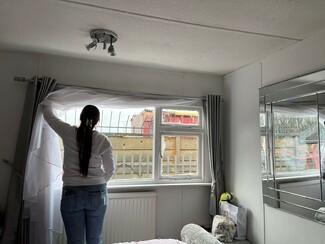
Kathleenanne Boswell, the senior youth officer for Leeds Gypsy and Traveller Exchange, understands full well the issues that confront residents of Mary Street, the site where she lives in Bradford. “The main problem is we are living in an industrial area. And it’s the air quality, the smell, the dust and the sound…the recycling centre is just behind us - and the sound, the noise is a problem…and we also have a big problem with rats.” The biggest rat that the site had to contend with, has thankfully disappeared. George, as he was called, first appeared a few years ago, rifling through the bins at a wake for a relative. “As big as a terrier, he was,” says Kathleenanne, “but I think he’s probably left some siblings behind him.”
The dry humour belies the multiple problems with so many of the authorised Traveller sites around England, Scotland and Wales which I have mapped. (I also hope to do the same for the five Northern Irish sites which are currently open.) Perhaps as many as 75,000 community residents live on sites, many of which are run by local authorities or housing associations; I mapped 290 socially rented sites throughout the three nations.
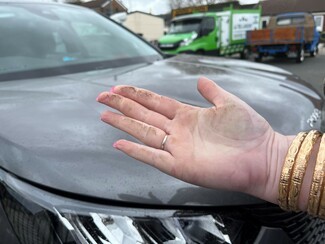
Using data journalism, I mapped the proximity of sites to hazards and unpleasant places, such as sewage stations, refuse and recycling centres, industrial areas and motorways and mainline rail lines, as well as rivers, canals or the sea, which can be both contaminated, bring vermin, or flood. I found that 39% were within 50 metres of the hazards, with over half (54%) being within 100 metres.
I wanted to find out how those sites were planned in such risky and unpleasant places to live. A small grant from the Paul Hamlyn Foundation Ideas and Pioneers Fund allowed me to investigate and reveal the unjust processes that explain the scandal of where and why Gypsy and Traveller communities have been and continue to be placed in areas which are polluted, noisy, vermin infested and where no other communities would be expected to live. This is a form of environmental injustice that affects the mental and physical health of residents.
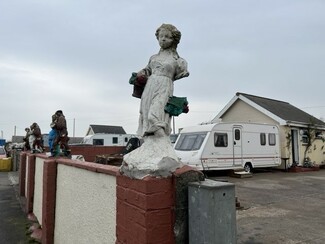
I made Freedom of Information (FOI) to look at planning history and Environmental Information Regulations (EIR) requests to look at current concerns regarding 20 sites across the nations. I visited Mary Street in Yorkshire and Rover Way in Cardiff, Wales, as well as a planned Hertfordshire site, interviewing representatives of local Gypsy and Traveller organisations and residents.
The planning history of the sites I investigated showed that council officials were all too aware of the risks of the locations in which they were placing Traveller sites; the EIR requests showed what can only be described as a hidden housing scandal. Residents raised concerns about sites plagued by insects and vermin, as well as complaining about noise and dust from industry, rail and roads. Many sites were affected by foul odours from sewage stations and businesses such as slaughterhouses. Other problems included busy traffic and vibration from lorries and industrial processes, causing the concrete slabs on which trailers sit to crack and other sites were liable to flooding.
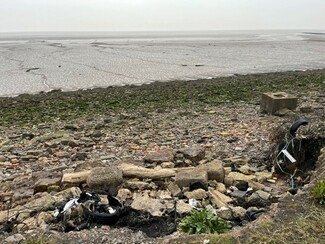
My investigation also showed that even new sites, currently in the planning process, face opposition by some local people, meaning that all too often sites are still being placed in unsuitable places. I wrote about one such, near the village of Bourne End, in Hertfordshire. The small site, much needed in the area, is planned to be next to the entire new housing development’s above ground sewage pumping station and is about fifty metres from a noisy rail mainline.
Other quieter sites were considered, with one near Tring, LA5, eventually dropped in 2016 after a local campaign. A local newspaper referred to ‘relief as Gypsy and Traveller site plans for Tring are scrapped’. One councillor said at a planning meeting in July 2016 that: “The proposed site in Tring is right on the entry to Tring which does not give a good first impression of the town” and suggested that Gypsies and Travellers should be offered houses instead. Another said that more sites would encourage ‘behaviours that residents do not want.” Dacorum Borough Council explained that they had made sure that the site was “well screened” from view, and would be near a cemetery extension, so well away from the living. Objections continued and eventually the site was pulled out of the planning process, as were other sites. That left only the current site, which was passed in December 2021.
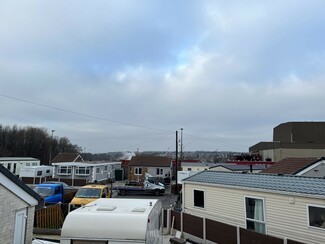
I found that planning officers were – and remain - well aware of the dangers and unsuitability of the sites they approved. The chief planning officer for the Bradford site, which is next to the council’s recycling centre, scrapyards and other industrial units, when he passed the site in 1974, wrote: “In my opinion the proposal envisages the introduction of a residential use into what is primary an industrial locality and as such is unacceptable. However, I have been given to understand that the use of this site as a Gypsy encampment has been agreed in principle by this authority and as such I would therefore recommend that no objection be raised subject to the usual conditions.” Almost 50 years later the site is still there and the conditions have worsened as the industrial plant has grown.
An Oxford site is right next to the city’s sewage works. Only since housing has been planned nearby has Thames Water come up with plans to reduce odour from the sewage works. Travellers have been living next to it for decades.
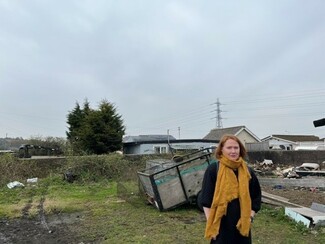
In Cardiff, Rover Way was described as dangerous and contaminated during a public inquiry in 1973, which nonetheless concluded: “Whether the site would be acceptable to the ordinary citizen, accustomed to a comfortable .. way of life seems to me irrelevant. The issue is whether the site would be suitable for a Gypsy encampment, in mind the squalid conditions in which many itinerant families presently exist.” In 1982 the City Environmental Health Officer for Cardiff stated that the site condition was “very bad” and was “heavily rodent infested…I would advise you that in my opinion the condition of the site is such to be prejudicial to the health of the inhabitants”. Almost 50 years after the site was built as many as four generations of families have endured living in dangerous and contaminated conditions.
I visited the site with Jasmine Jones, Co-ordinator of the charity, Gypsies and Travellers Wales. Each pitch is spotless, but the entrance to the site is marred by regular fly tipping. The road beyond the site is very busy and the view is dominated by the Celsa steelworks. A red dust, thought to be from the steelworks, sticks to the caravans and cars. It has to be hosed off every day so it does not corrode the aluminium. Jasmine Jones says that “the residents feel trapped on the site. The location of the current site is appalling. When the wind changes, smoke from the steelworks smells like burning rope.”
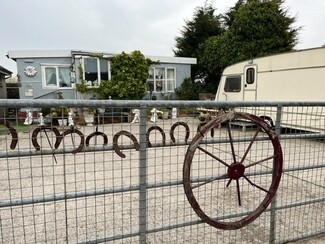
A Cardiff Council spokesperson said: “Cardiff Council is aware of the issues raised and is in constant dialogue with residents of the site to look at ways we can help alleviate concerns, this includes working with Celsa to reduce levels of dust which is impacting on all residents in the area, including the Traveller community. The Council is also working with partners to address any other environmental concerns, and with pest control to reduce rodent numbers. We recognise the constraints and problems posed by the Rover Way site.” Celsa Steel did not reply to a request for comment.
My work shows a past and present problem with planning for sites. The unholy trinity of political expediency, a planning system in hock to elected officials and objections by local settled people unites to make it more likely that nomadic community members, often local people themselves, are housed in hazardous or unpleasant places. Sites have been literally dumped by sewage stations, tips, busy roads and railways and this is not an accident. It is a national pattern that demonstrates the racism faced by Britain’s nomadic communities. The planning system facilitates marginalisation and exclusion over generations. Fifty years after the Caravan Sites Act was passed, sites are still being put in ‘hole and corner’ places, where no other community would be asked to live. Bill Forrester, who was tasked with finding some sites at this time, and was later chair of the National Association of Gypsy Traveller Officers, recalled planning meetings in the 1970’s and 1980’s. “It was very hard work, I’d go home sometimes and weep after public meetings, you despair for humanity really. You’ve got 400 people in a hall and I remember one woman put her daughter on stage during a public meeting and said ‘my nine-year-old daughter doesn't want to go to school with Gypsies’”.
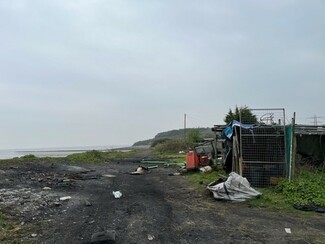
With the Policing, Crime, Sentencing and Courts Act coming into force at the end of June criminalising trespass this investigation also sheds light on why many Travellers need to travel during the summer months, when most unauthorised stopping happens. It is not only when Travellers travel to religious meetings, horse fairs and to visit families – it is to get some relief from sites which are even more unpleasant to live on in the warmer months, when the odours from tips, land fill, sewage and industry hang longer in the hot and still air, and when dust and flies are everywhere.
Julie Price, a grandmother from Rover Way, Cardiff, told me when I visited: “I can cope with the rats, but not the flies...I can't live where I can't cook in my own home in the summer. I dread the summer coming." Doreen Probert, another resident who grew up on the site, told me that the odour from drains, sewerage and a nearby sewage station was so bad in the summer that families would take their children to local parks after school and only come back in the evening, when they put in fragrance plug-ins to mask the smell.
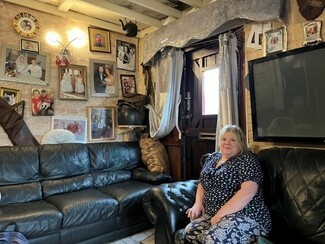
Trudy Aspinwall, team manager for the advocacy service, Travelling Ahead, which works the communites across Wales, told me: “There has been poor quality social housing in the past, but I would say sites are far worse..accountability and management are lacking”, as well as a “lack of political will” to improve sites at the local level” – although she pointed to the fact that the Welsh government, prompted by a partnership of organisations, is at least holding an inquiry into site provision. But reports and inquiries need to turn into action for residents.
Residents from both Mary Street and Rover Way told me about the vast numbers of flies and other insects that came in the summer months in particular. In Mary Street residents felt that they were linked, like the rats, to the recycling centre adjacent to the site; in Rover Way to the sewage station and drains. One resident from Rover Way told me: “the shops run out of fly paper around here in the summer. We can put a paper up in the morning and it’s black within the hour with flies.” A resident from Mary Street said, simply: “They wouldn't expect anyone but a Traveller to live here."
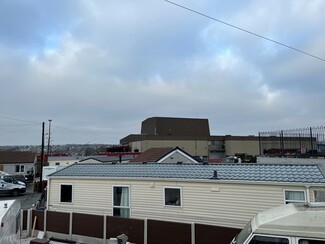
Reacting to the research, Pauline Melvin, chair of the Traveller Movement, said: “The health and safety of this already very disadvantaged group of people is being made worse by the terrible conditions they are forced to live in. Increases in cases of asthma, heart disease and other conditions leading to early death are a direct consequence of living in these appalling conditions which in many cases would not be considered suitable even for animals. The general acceptance of these low standards is a sign of the desperation of people to maintain their nomadic or site based life at all costs.”
Jo Richardson, Professor of Housing and Social Inclusion at De Montfort University, who is part of a new partnership to improve sites, commented on the research and journalism findings, saying that the work shows “that there is a need for real improvement on some Gypsy and Traveller sites…poor site management impacts on the physical and mental health and wellbeing of residents.” She added: “We should all have a decent place to call home.”
A spokesperson for Bradford Council said: “We have dedicated staff who work with residents at the Mary Street site and they work hard to do all they can to improve the conditions on the site and address issues as they arise for residents. Work is ongoing to look at longer term solutions to address and tackle these and other issues.”
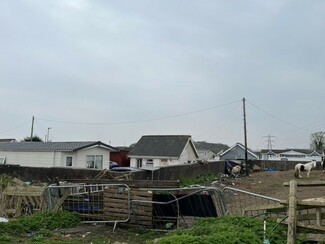
Rachel Cooper, Development Director for Leeds Gate, commented that the findings and journalism “give voice to what the community and residents already knew and have been campaigning on for decades- years of institutional and societal racism that has led to an untenable situation borne out in Gypsy and Traveller people's life expectancy and suicide rates. Simply put, no other community would be expected to live on industrial estates flanked with tips and slaughterhouses."
Although some sites have been slated for closure for years, residents have not been able to move to more suitable places to live because some local people then object to new sites. Site conditions then deteriorate, with residents left living in limbo. In many cases, as many as four generations of families have lived on the same site.
Residents are all too aware of being housed in areas where nobody else would live - and in fact few sites are run by housing. Perhaps because of where they are located, most are run by Environmental Health. As one resident of Mary Street, Roseanne Price, told me: “We are run by the people who kill the rats; we pay rent as council tenants, but we are run by environmental health. The way I feel is like everybody else on the site, we have been brushed off. They just think, ‘you choose to live like this, this is your culture, it’s a lifestyle choice. You want to live here, so that’s it basically.’ This is all we have to offer you.”
By Katharine Quarmby
(Lead photograph: Mary Street, Bradford. Kathleenanne Boswell looks out of her window at the local tip and recycling centre. All photographs © Katharine Quarmby)